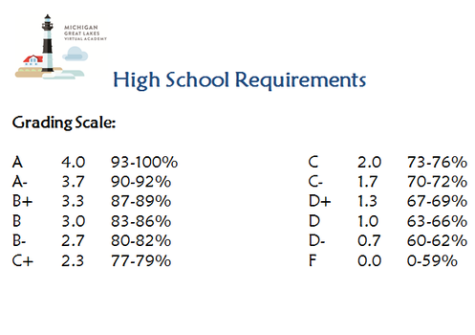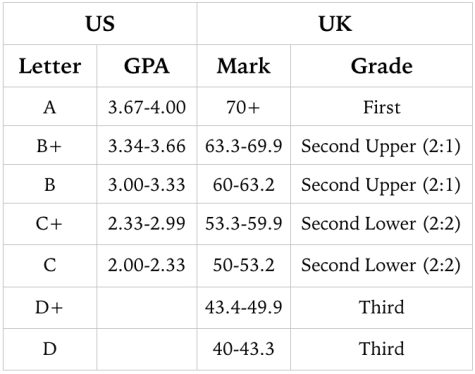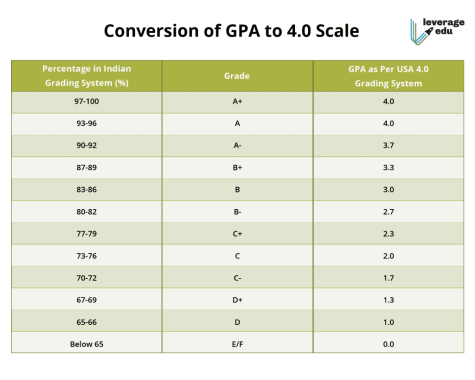What do grading systems look like on a worldwide scale?

More stories from Arpita Das

Grading systems can vary among countries worldwide.
For the past 16 years, I have lived in America, but as someone who has parents from India—who moved all the way across the world to America—it can often be difficult to understand the significance behind grades and why they are scaled the way that they are. For example, whenever my parents said that they never had exams or that AP classes weren’t a thing, it made me wonder what the school system is like in different parts of the world.
America’s grading system –
Schooling in America is split up into three divisions. First, there is an elementary school (K-5), middle school (6-8), and lastly high school, (9-12) which is often the longest and most important years of schooling.
America’s grading system is based on a 4.0 scale, and it has certain percentages that correlate to the first seven letters of the alphabet. Below is a diagram that shows what percentages correlate to which letter, along with a numerical value displaying your GPA (Grade Point Average) based on a certain percentage that you get in a class.

Upon entering high school, you are required to take six classes per year. Four out of the six are your core classes—Math, Science, English, History—and the other two are electives.
There is also the option of taking Advanced Placements courses (AP), provided by the College Board. This is an organization that gives students the opportunity to take college-level courses at the high school level, and potentially earn some college credits. To earn credit each AP exam is ranked on a five-point scale from (one-five) one being the lowest and five being the highest. To get a passing score, you must get a three or higher to be able to submit it to colleges.
Benefits include a weighted GPA and the overall satisfaction of being able to challenge yourself academically. Cons include not being able to earn college credit, but still getting the high school graduation requirement from taking the class.
The majority of Americans go through the mandatory twelve years of education to get their high school diploma and attend college. But the youngest age at which you can drop out is 16 or 17, depending on the state you live in.
Whenever my parents would say that they never had exams or that AP classes weren’t a thing, it sometimes made me wonder what the school system is like in different parts of the world.
As you progress through the grade levels, the course content also becomes more difficult. However, no matter what grade you are in almost all students have standardized testing. Standardized testing is part of the reason why high school is the most important year of schooling. These are the years when colleges actively monitor your extracurricular activities, along with academics, and test scores.
Tests such as the Scholastic Aptitude Test (SAT) score you in four sections: reading, writing, math with no calculator, and math with a calculator. The highest score you can get is 1660, and you can take it as many times as you wish in order to get the desired result.
Another standardized test is one known as the American College Testing (ACT). The ACT is focused on testing in a wide range of subjects, such as science or reading. The highest score you can get on the ACT in each subject is a 36.
United Kingdom Grading System –
According to brightworldguardinships.com, the UK education system is split into four parts: primary education, secondary education, further education, and higher education.
Primary education is two years long, from the ages of five to seven. Secondary education is four years long and is from the age of seven to eleven. Further education is three years and is from the age of 11 to 14. Higher education is two years and is from the age of 14 to 16.
The Grading Scale for The United Kingdom goes as follows.

The majority of schools within the UK combine primary and secondary education, meaning that this stage of learning can start from the age of 5 and end at the age of 11. During students’ second year of schooling (primary education)—around the age of six or seven—is when they prepare to take standardized testing. They do this again during their sixth year of schooling (secondary education) around the age of 10 or 11.
Students’ seventh and eighth years of schooling in the UK usually mark the beginning of their secondary education. This can sometimes mean that they are a part of a junior school or senior school. During this stage of their learning, all students are required to take all the core subjects—Maths, Science, History, Language Arts—along with a foreign language and a couple of classes and/or subjects of their own choosing. After year eight is when students are enrolled to take the Common Entrance exam, which can be taken during either January, May, June, or November.
Year nine is the most important year for a student’s education in the UK. In US terms, this is the senior year for students and is when they take their General Certificate of Secondary Education (GCSE). The GCSE tests students on 12 courses in total, half of which are core subjects, and the other half are free choice by the students themselves. The reason why GCSEs are held to such a high standard is that it’s a test to see if you can get into college and if you are prepared for higher studies.
Along with the standard two-year program for the GCSE, there is also an extensive 1 year GCSE program that tests up to six subjects, for students fifteen and older. Lastly, there is the International General Certificate of Secondary Education (IGSCE). Similar to GSCE, IGSCE is a more accessible way for students to earn their degree in college and can test a maximum of seven subjects.
India’s grading system –
According to the website gnu.org, India’s grading system is split into four levels, lower primary (six to ten), upper primary (11 and 12), high (13 to 15), and higher secondary (17 and 18). Similar to America, the grades and percentages are the same, except in India their grade goes up to an A+ for any percentage of 97% or higher, and a letter grade of an E/F account for a percentage below 65%. But in terms of GPA in India, the term for it is Cumulative Grade Point Average (CGPA), and the way that it is calculated is on a 10-point scale.
In America, percentages are divided by 100 and then multiplied by 4, but in India, the percentage is divided by 9.5 and then ranked by four divisions. 75% and above is rated as “Distinction”, and 60-75% is “1st division.” 50-60% is “2nd division” and 40-50% is “3rd division.”

10 years of schooling are required in India. However, your 10th and 11th years of schooling or junior and senior years and considered your college years. Just like in America, each year of school requires six courses per semester. Four out of the six are your core classes, along with a language of your choice, and a music course. The majority of the languages offered in India range from a variety of different cultures, but the main ones offered are usually Hindi and Sanskrit.

Arpita is a senior entering her third and final year as a staff writer on The Central Trend. She has been a part of the Science Olympiad team since the...

























































































